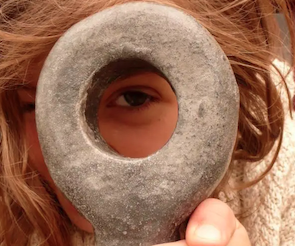
Maya Deren ( 1917–1961) was a Ukrainian born, American experimental filmmaker and artist, playing a crucial role in the American avant-garde period of the 40s and 50s. Known for her rather surreal work, she explored the subconscious and poetic potential of film, something few filmmakers were doing at the time, especially known women. Although her most recognised works lie in film, Maya was also a choreographer, dancer, film theorist, poet, writer, and photographer.
I first came across Deren’s work through her film ‘Meshes of the Afternoon’ (1943), an experimental, non-narrative short film co directed by both Deren and her then-husband Alexander Hammid. It is an incredibly surreal piece in which the protagonist (played by Deren herself) enters into a dreamlike state, her unconscious mind drifts between reality and imaginary. Deren explained that she wanted “to put on film the feeling which a human being experiences about an incident, rather than to record the incident accurately.” This is conveyed through the camera capturing only her subjective focus.
Meshes of the Afternoon really established the independent avant-garde movement of film in the States, a movement now known as the New American Cinema. Through her extensive work, Deren became the voice of avant-garde cinema of that period.
‘Meshes of the Afternoon’
For the time, it was rare to find a lot of women creating such abstract work and getting the recognition they deserved for it, and so when I discovered Deren’s work I felt incredibly inspired and opened up to a world of cinema that not only was so different to previous work, but also influenced an entire life of film to follow.
Deren began her career with Katherine Dunham’s dance troupe, which was famous for exploring the mythological roots of Caribbean rituals, and by 1942 she began writing and publishing articles, specifically, about Haitian religion and dance. Focusing on Vodou, and its spiritual implications, she felt inspired to spend several years in Haiti, first to photograph Haitian dance and Vodou rituals. Deren spent eighteen months in Haiti between the years of 1947 and 1952, accumulating 18,000 feet of film taken with her hand-held Bolex camera.
Vodou, although thought to be a kind of black magic, is actually a kind of religion where Gods and spirits can be invoked directly to earth and join the festivities of rituals. The Gods aren’t worshipped as remote entities, but instead involved as one of the dancers, in which the individual that becomes possessed by the god disappears and transcends beyond their physical body. Reality becomes an expression of the spiritual world, while it also feeding the real world back into the spiritual realm.
Deren became engulfed by the Haitian ritual cultures and during her time their produced a significant collection of work including; a 52 minute documentary film- ‘Divine Horsemen: The Living Gods of Haiti’, along with a book of her extensive fieldwork and personal experiences in Haiti- also called ‘Divine Horsemen: The Living Gods of Haiti’, as well as, ‘Voices of Haiti’- an album of Haiti’s percussion and chant heavy ritual music, it is one of the earliest and best ethnographic documents of vodou culture in Haiti.
‘Voices of Haiti’- Ghede Nimbo.
She had an fixation throughout her life between the real and the imaginary, the rational and irrational, “I am concerned, with that point of contact between the real and the unreal, where the unreal manifests itself in reality.” Her work acted as a place in which this ‘point of contact’ could be made visible. And so it becomes completely transparent as to why she was so intrigued by Haitian Vodou culture. The overlap of a physical reality with a surreal, spiritual world in Haitian religious practices, encompasses her own fascinations. Deren’s deep involvement with Vodou, can be seen as her pursuit and interest to a living culture that gives credibility to the ‘unreal’, providing her with a presence she presented throughout her films.
I find Deren an incredibly inspiring artist, I am able to appreciate all her forms of work, however, especially her films. Experimental, surreal films have always intrigued me, the visual aesthetics and the narratives that come with the genre have influenced my style of work massively, both in my film making and sound work. I love the freedom that comes with it and I think Deren’s work is a perfect example of how to use that freedom.
